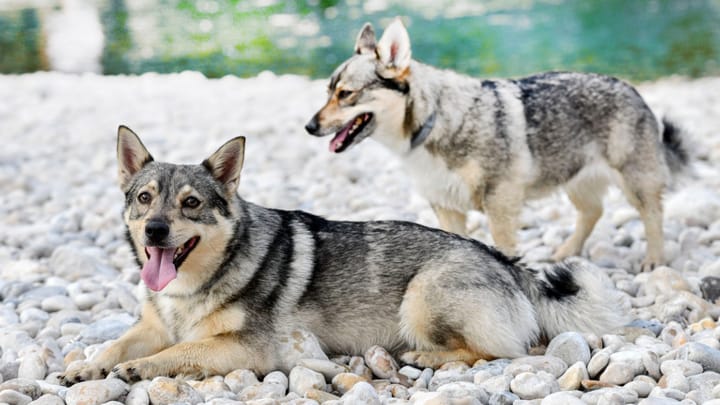Swedish Vallhund
Other names : Wisigoths Spitz, Västgötaspets, Swedish Cow Dog, Wolf Corgi

The Swedish Vallhund is an energetic, jolly, friendly and smart small-medium dog breed. Originally used to work on Swedish farms as a herder and ratter, the breed has become a popular family companion dog due to its loyal and affectionate temperament. While this cheerful breed certainly makes for a great pet, potential adopters should be aware that it’s a lively breed which requires plenty of exercise and mental stimulation.
|
Life expectancy |
The Swedish Vallhund has a life expectancy of between 12 and 14 years |
|
Temperament |
|
|
Size |
Medium
|
|
Adult size |
Female
Between 11 and 13 in
Male
Between 12 and 14 in
|
|
Adult weight |
Female
Between 20 and 31 lb
Male
Between 20 and 31 lb
|
|
Coat colour
Red-brown, grey, grey-brown, red-yellow, grey-yellow and other variations of the same shade. |
Brown Blue Red Sand |
|
Type of coat
Double, weather-resistant. |
Long Hard |
|
Eye colour
The eyes are dark brown. |
Brown
|
|
Purchase price |
The Swedish Vallhund costs between £400 and £1000 |
Interestingly, Vallhunds are born with different tail lengths - in fact, some even have no tail whatsoever!
More details about the Swedish Vallhund
Swedish Vallhund: Origins and history
The Swedish Vallhund used to be known as the ‘Viking Dog’ because, according to Swedish records, it was brought to Sweden over a thousand years ago by (you guessed it!) Vikings. Many also believe the Vikings travelled to Wales with this breed, which then contributed to the evolution of the much-loved Corgi, hence the similarity. The breed was generally used to work on farms for herding, ratting and guarding, but slowly gained popularity as a companion dog.
Physical characteristics of the Swedish Vallhund
The Swedish Vallhund is extremely similar in appearance to the beloved Corgi. This breed is long and short yet fairly stocky and robust. The head is long, with a defined stop and square muzzle. The eyes are oval-shaped and dark, while the medium-sized ears are relatively large, erect and pointy.
FCI classification of the Swedish Vallhund
-
Group 5 - Spitz and primitive types
-
Section 3 : Nordic Watchdogs and Herders
Swedish Vallhund: Characteristics
Swedish Vallhund: Behaviour
Training a Swedish Vallhund
This is a smart dog who understands quickly what is asked of it, but as always it is important to establish yourself as a leader from the get-go. Start training the Vallhund while it’s still young, using plenty of positive reinforcement.
Swedish Vallhund: Lifestyle
Breed compatibility Swedish Vallhund
Swedish Vallhund: Purchase price
This breed is fairly hard to come by in the UK. If you come across a litter, you’re likely to be looking at a cost of between £400 for a Non KC Registered dog, and £1,000 or more for a KC Registered pup. Looking after a dog of this size typically costs between £50 to £80 a month, including food, medical/insurance, and incidental expenses.
Swedish Vallhund: Shedding
Average
This breed is a moderate shedder.
Swedish Vallhund: Grooming
The Swedish Vallhund does shed, so you’ll need to brush it regularly to ensure your house doesn’t get absolutely covered in fur. Twice a week is a good starting point. The rest is normal canine care. Trim the nails if needed, clean the ears every couple of weeks, and brush the teeth as often as possible.
Swedish Vallhund: Health
The Swedish Vallhund is generally healthy, but is particularly prone to a genetic eye disease which can cause blindness. The average life expectancy for this breed is 13 years.
Despite its short legs, the Vallhund has a strong, stocky body and is known to be fairly robust.
The Swedish Vallhund prefers cold weather to extremes of heat. Provide cold water and shade when the weather warms up.
Originating from Sweden, the Vallhund is used to cold climates and, thanks to its thick, double coat, tolerates bitter weather very well.
Even though this isn’t a large dog, remember it requires quite a lot of exercise to keep in shape.
- Progressive retinal atrophy
- Hip dysplasia






